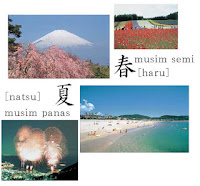Explore Japan - Housing, Food and Clothing
Lifestyle in Japan changed dramatically after World War 2, when many people from the region moved to big cities to earn a living as an office employee. With the growth of cities, both size and population, more and more people are going back and forth from their suburban apartments or homes to their workplaces in the downtown areas. Traditionally the traditional households consisted of three or more generations living in one house. Today urban households tend to consist of parents and children only, while grandparents live elsewhere.
Home
Traditional Japanese houses are made of wood and supported by wooden poles. Today, however, Japanese homes typically have Western-style rooms with wooden floors and are often built with steel poles. Moreover, more and more families in urban areas live in large concrete steel concrete buildings.
There are two major differences with Western homes, that is, people do not wear shoes inside the house and there is at least one room that tends to be designed in Japanese style, tatami-style. People take off shoes once they enter the house to keep the floor clean. Genkan, entrance, is a place to take off shoes, put them down, and put them back on. After removing the shoes, the Japanese wear house slippers.
Tatami is a kind of thick mat made of straw, has been used in Japanese homes since about 600 years ago. A tatami is usually sized 1.91 x 0.95 meters. Room size is usually based on the number of tatami. The tatami floor feels cool in summer and warm in the winter, and remains fresher than the carpet during the humid months in Japan.
FOOD
The term for eating in Japanese is gohan. This word actually shows rice, but because rice is a staple food for the Japanese, then gohan has been interpreted as rice with side dishes pauknya. The traditional Japanese meal consists of a bowl of white rice, with a main dish (fish or meat), complementary side dishes (usually vegetables), soups (usually miso soup), and pickled vegetables. Japanese rice sticky (like sticky rice), making it suitable to eat with chopsticks.
The Japanese today eat a wide variety of foods from around the world, mainly from Europe, North America, and Asia. In addition to rice, Japanese eat bread, noodles, and pasta, and love a wide variety of meat dishes, fish, vegetables, and fruits. Sushi, tempura, sukiyaki, and other world-renowned Japanese foods are, of course, also popular in Japan.
In big cities, in particular, there are many fast-food restaurants that provide burgers and fried chicken, which are popular especially among young and children.
Before eating, the Japanese say "itadakimasu", a polite expression which means "I accept this food." This is a thank you to anyone who has been involved in preparing the food. After the meal, the Japanese expressed their thanks again by mentioning "gochisosama deshita", which literally means "Thank you for the delicious and plentiful delicacies."
CLOTHES
The traditional Japanese outfit is a kimono. In general, kimono made from silk, a large sleeve that starts from the shoulder to the heel. Obi is a wide kimono belt. Nowadays kimonos are usually only worn on special occasions, such as New Year's, Shichi-Go-San festivals, wedding ceremonies, and graduation ceremonies.
Compared to Western clothes, kimonos tend to limit movement and it takes more time to wear them properly. While in the summer, children and young adults wear a kind of light informal kimono known as yukata at festivals, fireworks parties, as well as other special occasions. But in everyday life, young people tend to prefer to wear clothes that make it easier to move, such as t-shirts, jeans, polo shirts, and sweat suits
Home
Traditional Japanese houses are made of wood and supported by wooden poles. Today, however, Japanese homes typically have Western-style rooms with wooden floors and are often built with steel poles. Moreover, more and more families in urban areas live in large concrete steel concrete buildings.
There are two major differences with Western homes, that is, people do not wear shoes inside the house and there is at least one room that tends to be designed in Japanese style, tatami-style. People take off shoes once they enter the house to keep the floor clean. Genkan, entrance, is a place to take off shoes, put them down, and put them back on. After removing the shoes, the Japanese wear house slippers.
Tatami is a kind of thick mat made of straw, has been used in Japanese homes since about 600 years ago. A tatami is usually sized 1.91 x 0.95 meters. Room size is usually based on the number of tatami. The tatami floor feels cool in summer and warm in the winter, and remains fresher than the carpet during the humid months in Japan.
FOOD
The term for eating in Japanese is gohan. This word actually shows rice, but because rice is a staple food for the Japanese, then gohan has been interpreted as rice with side dishes pauknya. The traditional Japanese meal consists of a bowl of white rice, with a main dish (fish or meat), complementary side dishes (usually vegetables), soups (usually miso soup), and pickled vegetables. Japanese rice sticky (like sticky rice), making it suitable to eat with chopsticks.
The Japanese today eat a wide variety of foods from around the world, mainly from Europe, North America, and Asia. In addition to rice, Japanese eat bread, noodles, and pasta, and love a wide variety of meat dishes, fish, vegetables, and fruits. Sushi, tempura, sukiyaki, and other world-renowned Japanese foods are, of course, also popular in Japan.
In big cities, in particular, there are many fast-food restaurants that provide burgers and fried chicken, which are popular especially among young and children.
Before eating, the Japanese say "itadakimasu", a polite expression which means "I accept this food." This is a thank you to anyone who has been involved in preparing the food. After the meal, the Japanese expressed their thanks again by mentioning "gochisosama deshita", which literally means "Thank you for the delicious and plentiful delicacies."
CLOTHES
The traditional Japanese outfit is a kimono. In general, kimono made from silk, a large sleeve that starts from the shoulder to the heel. Obi is a wide kimono belt. Nowadays kimonos are usually only worn on special occasions, such as New Year's, Shichi-Go-San festivals, wedding ceremonies, and graduation ceremonies.
Compared to Western clothes, kimonos tend to limit movement and it takes more time to wear them properly. While in the summer, children and young adults wear a kind of light informal kimono known as yukata at festivals, fireworks parties, as well as other special occasions. But in everyday life, young people tend to prefer to wear clothes that make it easier to move, such as t-shirts, jeans, polo shirts, and sweat suits



Komentar
Posting Komentar